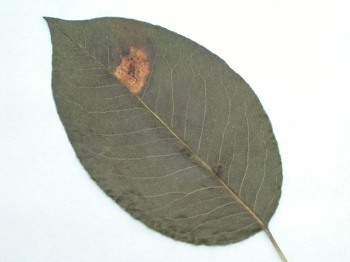Diseases
Gymnosporangium sabinae G. Winter - Rust of Pear
Systematic position.
Division Basidiomycota, class Teliomycetes, order Uredinales, family Pucciniaceae, genus Gymnosporangium.Biological group.
It is a biotroph.Morphology and biology.
The pathogen of the Pear Rust is a parasite with a biennial development cycle, having two hosts. The main host plant is pear and the intermediate one is juniper. The fungi develop over a period of approximately 20 months on juniper and 4-5 months on pear. In the spring, 17 months after infestation a large quantity of teleutospores (38-50 X 22-28 microns) appear on the shoots, branches, and stems of juniper, looking like horn-shaped conic processes. Teleutospores sprout in basidia which infest pear in the spring, implanted in parenchyma and give rise to mycelium. Spermagonia are formed on the mycelium, where aecia (polyhedral in shape, 25-38 x 22-25 microns) are formed. Juniper is a necessary host- plant for the further development of aecia; however uredespores are not formed here, and the fungus must infest pear again. Thus, the development cycle of the Pear Rust pathogen is continuous (it is not interrupted by a dormant period of winter spores) and obligatory heterogeneous. The fungi infest all above ground parts of the plant. First traces of the Rust on pear leaves appear at the end of April and in the beginning of May in the form of small rounded sulphur spots that are 0.5 mm in diameter. Their size increases gradually, and affected tissue of leaf swells. Spermagonia become noticeable on spot surface 2-3 days after appearance of the first visible attributes of the disease. They develop on the upper side of leaf, half plunged into tissue. Cells of the infected tissue on the lower side of the leaf increase their size and change their shape. The Rust is shown on new branches and fruit-bearings in the form of sulphureous at first, later orange-red or crimson spots. Diseased shoots stop growing but continue to increase in diameter. A modified branch or short thick "stub. is formed as a result.Distribution.
The area of distribution in the former USSR includes the Krasnodar and Stavropol Territories, Adygea, Karachay-Cherkessia, Crimea, Ukraine, Eastern and Western Georgia.Ecology.
Development of the Rust occurs with a wide range of temperatures (from 3 to 30.C, optimum temperature is 18.C) and relative air humidity (84-91%).Economic significance.
Rust decreases the vital capacity and longevity of trees, and also decreases productivity and deterioration of fruits. Control measures include the use of plant cultivars that are less susceptible to the disease, use of sanitary actions directed at decreasing infection reserve and also chemical treatments.Reference citations:
James P.W., Hawksworth D.L. 1971. Ainsworth & Bisby.s dictionary of the fungi. 6th edition. Kew: CAB International. 663 p.Khokhryakov M.K., Dobrozrakova T.L., Stepanov K.M., Letova M.F. 2003. Keys to plant diseases. St. Petersburg: Lan. 592 p. (In Russian)
Mitrofanova O.V. 1968. The Rust of pear in Crimea (species composition of pathogens, morphology, biology, the causes of epiphytotic development, protective measures). Leningrad: LSKHI. 21p. (In Russian)
Mitrofanova O.V. 1970. The rust of pear and its control. Simferopol: Crimea. 46 p. (In Russian)
Petrushova N.I., Mitrofanova O.V. 1972. Biological features of the Pear Rust pathogen Gymnosporangium Dobrozrakovae O.V. Mitrophanova in Crimea. Pests and diseases of fruit and ornamental plants. V. 61. Yalta: State Nikitin Garden. 123-132 p. (In Russian)
Smolyakova V.M. 2000. Diseases of orchard in the South of Russia. Krasnodar: Vest.. 192 p. (In Russian)
Tsvedadze L.P. 1987. Biological features of the Pear Rust development and its control in conditions of Georgia. Yerevan: Goskomisdat Georgian SSR. 24 p. (In Russian)
© Bilder I.V.


